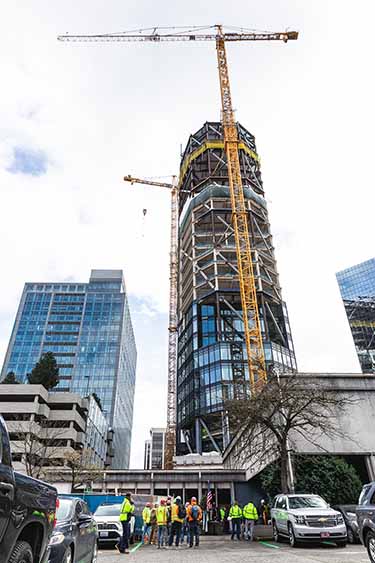|
Subscribe / Renew |
|
|
Contact Us |
|
| ► Subscribe to our Free Weekly Newsletter | |
| home | Welcome, sign in or click here to subscribe. | login |
Construction
| |
August 24, 2023
Report: construction supply chain has stabilized but prices remain elevated
Construction Editor
Skanska has released its summer report on construction market trends, which covers several metro areas across the country including Seattle and Portland.
Skanska said we're now in the most expensive construction environment ever, though the industry remains strong amidst a shifting economy. Strength is coming from growth in the infrastructure, data and technology, life science, manufacturing, aviation and education sectors. Pulling against that are the office and residential markets, which are being pressured by high interest rates, and by high vacancy rates in the case of offices.
“As the federal reserve considers additional interest rate hikes to fight inflation, we believe it is likely that other general industry clients will become more conservative and presently strong sectors may initiate capital spending pullbacks,” wrote Steve Stouthamer, Skanska executive vice president of project planning, in the report.
In a webinar covering the report on Wednesday, Kez Gneiting, national supply chain manager for Skanska, said the outlook for the supply chain has continued to stabilize over the past quarter. Gneiting noted that supply lead times for materials are returning to normal levels experienced pre-pandemic, but didn't expect overall prices to drop back to those levels. Elevated costs due to labor and freight are here to stay, she said.
The report revealed lower prices for PVC resins, steel, copper and lumber over the past three months have helped improve the supply chain. Prices for those materials have weakened due to reduced residential demand and increased capacity as the supply chain normalizes to pre-pandemic levels.
The report added that lead times for roofing, structural steel, architectural interior, plumbing, electrical commodity and wood-based products are coming back to normal levels, with prices stabilizing, though at escalated levels. “Barring any disruptions, price and lead times are forecasted to remain stable in these categories over the next 6-12 months,” the report read.
HVAC and electrical gear supply chain challenges continued from last quarter due to component, labor and equipment capacity shortfalls. The report said several major HVAC equipment manufacturers reported significant improvement in backlog due to investment in new facilities, new equipment and hiring of additional workers to increase output. Still, lead times were 25-65 weeks for HVAC equipment and 50-100 weeks for electrical gear.
With these improvements and lower raw material costs, HVAC equipment lead times have likely peaked and will decrease for the remainder of 2023, the report read. That doesn't mean prices are coming down, however. Prices are on track to increase 10%-15% this year, but may return to normal increases of 3%-5% next year, according to the report.
The outlook for electrical equipment was a little more bleak because demand for these items is expected to remain high from the continuing electrification trend and investments in data centers, which are likely to last for several more years. “Even though most manufacturers are investing hundreds of millions of dollars in capacity, the persistent strong demand will only moderately reduce lead times over the next 12 months,” the report said.
Gneiting noted that commodities used for many construction inputs have stabilized due to less demand from China.
The report recommended that contractors make early purchases of items in tight supply in order to meet project schedules.
The big price movers of construction materials over the last quarter were: gypsum up 11.2%; asphalt up 5%; stainless steel up 4.6%; 2x4 boards up 4.6%; concrete up 3.2%; and Portland cement up 2.9%. Price drops were found in standard plate steel (down 4.5%) and unfaced insulation (down 3.4%).
Over the past year, these materials were higher in price: gypsum up 27.3%; unfaced insulation up 18.2%; Portland cement up 17.8%; stainless steel up 8.4%; and concrete up 8.4%. Some materials dropped over the year: plywood down 22.5%; standard plate steel down 16.8%; and 2x4 boards down 15.2%.
For the Seattle area, the report expects construction price inflation to be above normal, between 3%-5% per annum, for the next year. Then, prices are expected to be within traditional indices (less than 3%) going two years out.
The report says cruise season is back to normal, which is fueling tourism downtown and re-energizing the retail, hospitality and aviation sectors in the Seattle area. This is helping offset slowed starts for new downtown residential and office space. Outside of downtown, “plenty of opportunities for new projects” are available in the K-12 schools, mass transit and aviation sectors, according to the report.
Local prices will continue to be pushed by new labor agreements and the ongoing shortage of labor, as well as the availability of materials and equipment. But, more aggressive margins and lower costs for lumber and shipping are helping keep overall prices in check.
In Portland, construction price inflation is expected to be above normal for the next six months, then within traditional indices going two years out. The report said the Portland metro area project pipeline is slowing considerably and competition is picking up. This is resulting in more proposers and tighter margins on projects. The report added that major infrastructure projects will consume adjacent resources and may buoy the overall construction market.
Benjamin Minnick can be
reached by email or by phone
at (206) 622-8272.



